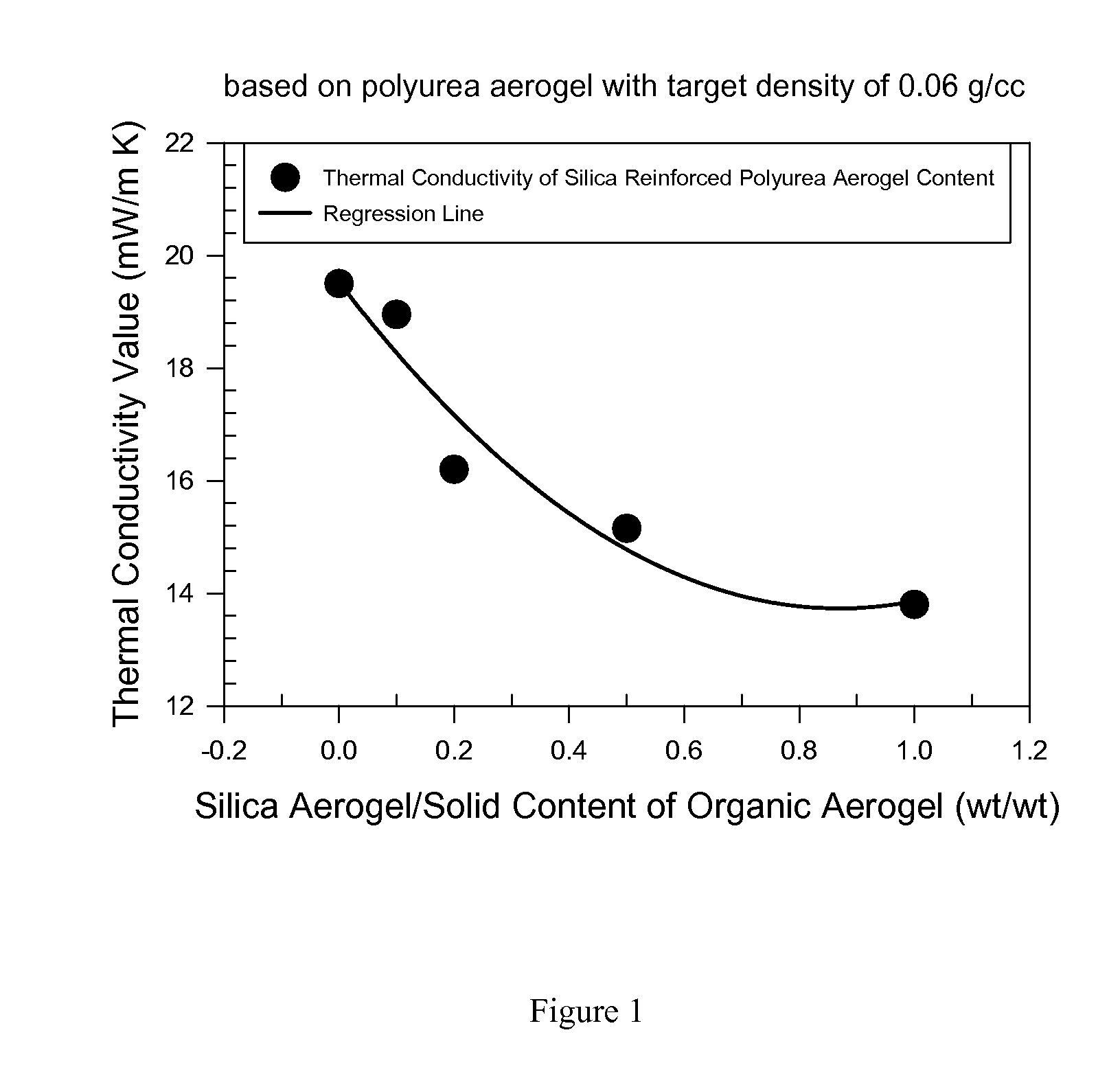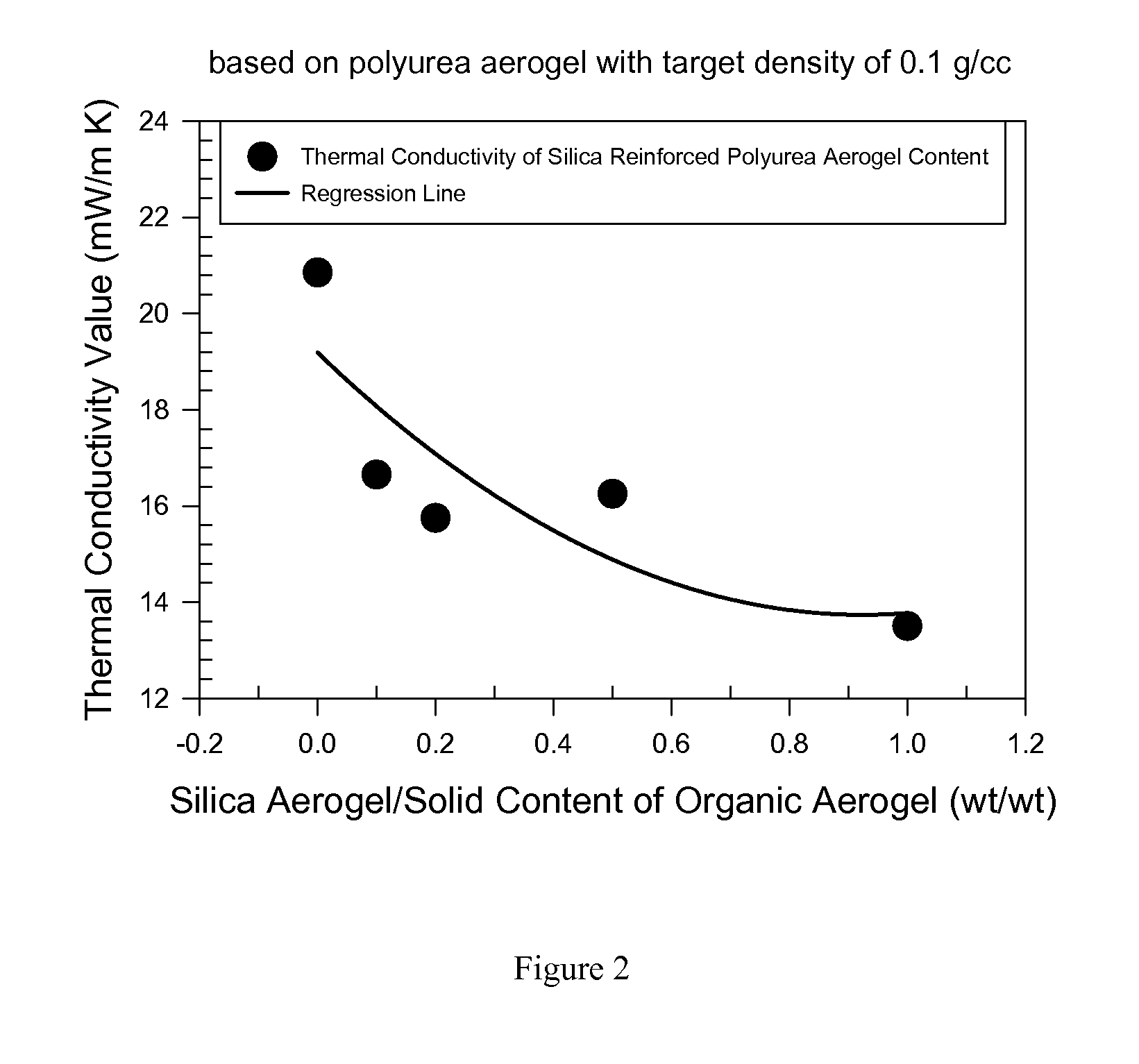Organic aerogels reinforced with inorganic aerogel fillers
an aerogel and inorganic technology, applied in the field of organic aerogels comprising inorganic aerogel fillers, can solve the problems of strong material potentially exhibiting stronger compressive strength, and achieve the effects of moderate shrinkage and densification, and increased density of final aerogels
- Summary
- Abstract
- Description
- Claims
- Application Information
AI Technical Summary
Benefits of technology
Problems solved by technology
Method used
Image
Examples
example 1
[0109]In order to prepare the polyurea based organic polymer aerogel containing no silica aerogel fillers, the isocyanate solution was prepared. First, 5.38 g of poly-MDI was weighed into a polypropylene container with a screw cap. Subsequently 117.54 ml of acetone was added and the mixture was stirred to obtain a homogeneous solution. 2.05 g of Jeffamine T-3000 polyamine was added to this mixture and blended until a homogeneous solution was obtained. To this solution 5.11 ml of TEA catalyst solution diluted in ethanol (10 / 90 wt / wt) was incorporated. After stirring thoroughly to ensure a homogeneous dispersion of the catalyst through the mixture for 1 min, the time to gelation was recorded. Some of the sol was poured into a plastic container containing quartz fiber batting in order to prepare fiber-reinforced samples as well. Containers for the monolith and composite were closed and sealed to prevent evaporation and the contents were maintained in a quiescent condition to form a pol...
example 2
[0112]The silica aerogel was first prepared using previously described techniques. 34.76 mL of an ethylpolysilicate solution was weighed into a polypropylene container with a screw cap. Subsequently, 69.62 mL of ethanol was added and the mixture was stirred to obtain a homogeneous solution. Next, 15.60 mL of water was added to the solution and blended thoroughly for 30 min. To this, 10 mL of ammonia solution diluted in ethanol (10 / 90 wt / wt) was added dropwise. After stirring thoroughly for 1 min, a timer was started to obtain the gel time. The silica sol was poured into plastic containers to prepare monoliths. Containers for the monolith were closed and sealed to prevent evaporation and the contents were maintained in a quiescent condition to form a polymeric silica wet gel. After waiting further 30 min to ensure uniform gelation of the mixture, dilute hexamethyldisilazane / ethanol solution (5 / 95 v / v, HMDS against ethanol) was added into polymeric gel in an amount to form solution la...
example 3
[0118]The isocyanate solution was prepared. First, 5.38 g of poly-MDI was weighed into a polypropylene container with a screw cap. Subsequently 117.54 ml of acetone was added and the mixture was stirred to obtain a homogeneous solution. Next, 1.49 g of the silica aerogel powder prepared above were added slowly to this mixture and blended until a homogeneous solution was obtained. 2.05 g of Jeffamine T-3000 polyamine was added to this mixture and blended until a homogeneous solution was obtained. To this solution 5.11 ml of TEA catalyst solution diluted in ethanol (10 / 90 wt / wt) was incorporated. After blending the solution for 1 min, the same method as described in Example 1 was used for the gelation and aging steps.
[0119]Once the aging process was completed, the wet gel was loaded into a pressure vessel and supercritically dried using the same method as described in example 1. The resulting polyurea based aerogels reinforced with silica aerogel fillers were opaque and had slightly y...
PUM
| Property | Measurement | Unit |
|---|---|---|
| Pore size | aaaaa | aaaaa |
| Pore size | aaaaa | aaaaa |
| Size | aaaaa | aaaaa |
Abstract
Description
Claims
Application Information
 Login to View More
Login to View More - R&D
- Intellectual Property
- Life Sciences
- Materials
- Tech Scout
- Unparalleled Data Quality
- Higher Quality Content
- 60% Fewer Hallucinations
Browse by: Latest US Patents, China's latest patents, Technical Efficacy Thesaurus, Application Domain, Technology Topic, Popular Technical Reports.
© 2025 PatSnap. All rights reserved.Legal|Privacy policy|Modern Slavery Act Transparency Statement|Sitemap|About US| Contact US: help@patsnap.com



